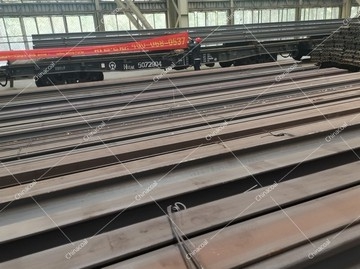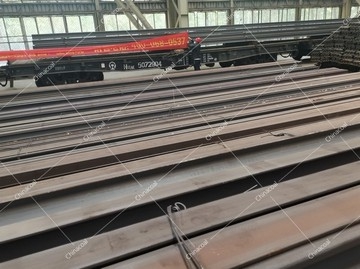Introduction
Steel railway rails are the fundamental components of rail tracks, providing a stable and durable surface for trains to travel on. They bear the weight of rolling stock, distribute load to the track foundation, and ensure smooth and safe train operations. Rails are manufactured to precise engineering standards to accommodate different rail systems, from heavy-haul freight lines to high-speed passenger networks.

Types of Steel Rails
By Weight & Profile
Light Rails (30–50 kg/m): Used for light rail transit (LRT), tramways, and industrial tracks.
Medium Rails (50–60 kg/m): Common in regional railways and freight lines.
Heavy Rails (60–75 kg/m and above): Designed for mainline railways, high-speed tracks, and heavy freight corridors.
By Material & Manufacturing Process
Carbon Steel Rails: Standard rails for general railway use.
Alloy Steel Rails: Enhanced with chromium, manganese, or vanadium for increased wear resistance.
Heat-Treated Rails: Thermally processed to improve hardness and durability.
Head-Hardened (HH) Rails: Surface-hardened for extended lifespan in high-wear areas like curves and switches.
By Application
Mainline & High-Speed Rails – Optimized for stability at high velocities.
Crane & Industrial Rails – Used in ports, mining, and factory tracks.
Urban Transit Rails – Designed for metros, trams, and light rail systems.
Specialty Rails – Including grooved rails (for tramways) and guard rails (for safety).
Key Standards & Specifications
Different countries follow specific rail standards:
UIC (International Union of Railways): Standard profiles like UIC 60.
AREMA (American Railway Engineering and Maintenance-of-Way Association): Common in North America.
BS (British Standards): Such as BS 75R, BS 90A.
GB (Chinese National Standards): Including GB 2585 for heavy-haul rails.
JIS (Japanese Industrial Standards): Like JIS 50N, JIS 60kg.
Key Properties of Quality Rails
High Strength & Toughness – Resists cracking under dynamic loads.
Wear Resistance – Prolongs rail life under heavy traffic.
Corrosion Resistance – Essential for coastal or humid environments.
Fatigue Resistance – Withstands repeated stress cycles.
Applications in Rail Systems
Freight Railroads – Heavy-duty rails for coal, ore, and container transport.
Passenger Railways – Smooth, low-vibration rails for comfort.
Metros & Trams – Noise-reducing and grooved rails for urban use.
High-Speed Lines – Precision-engineered rails for stability at 250+ km/h.
Maintenance & Lifespan
Regular grinding to remove surface defects.
Lubrication on curves to minimize wear.
Replacement cycles typically range from 30 to 50 years, depending on traffic density.
Conclusion
Steel railway rails are critical to global transportation infrastructure, evolving with advanced materials and manufacturing techniques. Whether for freight, high-speed, or urban transit, selecting the right rail type ensures efficiency, safety, and longevity in rail operations.


